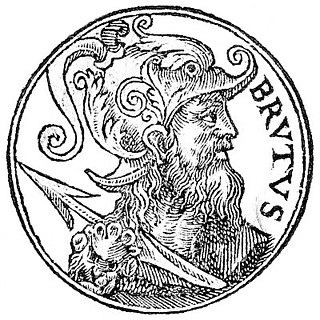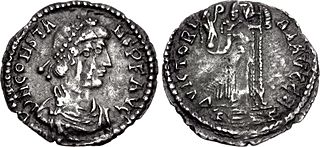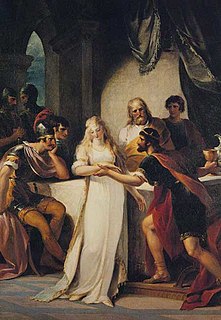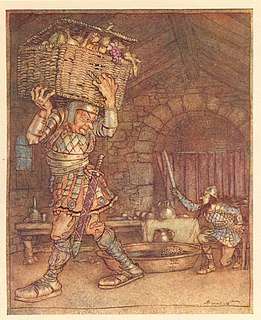
Ambrosius Aurelianus was a war leader of the Romano-British who won an important battle against the Anglo-Saxons in the 5th century, according to Gildas. He also appeared independently in the legends of the Britons, beginning with the 9th-century Historia Brittonum. Eventually, he was transformed by Geoffrey of Monmouth into the uncle of King Arthur, the brother of Arthur's father Uther Pendragon, as a ruler who precedes and predeceases them both. He also appears as a young prophet who meets the tyrant Vortigern; in this guise, he was later transformed into the wizard Merlin.

The Battle of Badon /ˈbeɪdən/ also known as the Battle of Mons Badonicus was a battle purportedly fought between Britons and Anglo-Saxons in Post-Roman Britain in the late 5th or early 6th century. It was credited as a major victory for the Britons, stopping the encroachment of the Anglo-Saxon kingdoms for a period.

Uther Pendragon, also known as King Uther, is a legendary king of sub-Roman Britain and the father of King Arthur. A few minor references to Uther appear in Old Welsh poems, but his biography was first written down in the 12th century by Geoffrey of Monmouth in his Historia Regum Britanniae, and Geoffrey's account of the character was used in most later versions. He is a fairly ambiguous individual throughout the literature, but is described as a strong king and a defender of his people.

Vortigern, also spelled Vortiger, Vortigan, Voertigern and Vortigen, was a 5th-century warlord in Britain, known perhaps as a king of the Britons or at least connoted as such in the writings of Bede and Gildas. His existence is contested by scholars and information about him is obscure.
The History of the Britons is a purported history of the indigenous British (Brittonic) people that was written around 828 and survives in numerous recensions that date from after the 11th century. The Historia Brittonum is commonly attributed to Nennius, as some recensions have a preface written in his name. Some experts have dismissed the Nennian preface as a late forgery, arguing that the work was actually an anonymous compilation.
Nennius – or Nemnius or Nemnivus – was a Welsh monk of the 9th century. He has traditionally been attributed with the authorship of the Historia Brittonum, based on the prologue affixed to that work. This attribution is widely considered a secondary (10th-century) tradition.

Dinas Emrys is a rocky and wooded hillock near Beddgelert in Gwynedd, north-west Wales. Rising some 76 m (250 ft) above the floor of the Glaslyn river valley, it overlooks the southern end of Llyn Dinas in Snowdonia.

Brutus, or Brute of Troy, is a legendary descendant of the Trojan hero Aeneas, known in medieval British history as the eponymous founder and first king of Britain. This legend first appears in the Historia Brittonum, an anonymous 9th-century historical compilation to which commentary was added by Nennius, but is best known from the account given by the 12th-century chronicler Geoffrey of Monmouth in his Historia Regum Britanniae.

The Matter of Britain is the body of medieval literature and legendary material associated with Great Britain and Brittany and the legendary kings and heroes associated with it, particularly King Arthur. It was one of the three great Western story cycles recalled repeatedly in medieval literature, together with the Matter of France, which concerned the legends of Charlemagne, and the Matter of Rome, which included material derived from or inspired by classical mythology.

Historia regum Britanniae, originally called De gestis Britonum, is a pseudohistorical account of British history, written around 1136 by Geoffrey of Monmouth. It chronicles the lives of the kings of the Britons over the course of two thousand years, beginning with the Trojans founding the British nation and continuing until the Anglo-Saxons assumed control of much of Britain around the 7th century. It is one of the central pieces of the Matter of Britain.

Constans II was the eldest son of the Western Roman emperor Constantine III and was appointed co-emperor by him from 409 to 411. He was killed during the revolts and fighting that ended his father's reign.
Vortimer, also known as Saint Vortimer, is a figure in British tradition, a son of the 5th-century Britonnic ruler Vortigern. He is remembered for his fierce opposition to his father's Saxon allies. In Geoffrey of Monmouth's Historia Regum Britanniae, he overthrows his father and reigns as King of Britain for a brief period before his death restores Vortigern to power.
Aurelius Conanus or Aurelius Caninus was a Brittonic king in 6th-century sub-Roman Britain. The only certain historical record of him is in the writings of his contemporary Gildas, who excoriates him as a tyrant. However, he may be identified with one of the several similarly named figures active in Britain during this period. In the 12th century Geoffrey of Monmouth adapted Gildas' account for his chronicle Historia Regum Britanniae, and thereafter Aurelius Conanus was remembered as a legendary King of Britain.

The historicity of King Arthur has been debated both by academics and popular writers. While there have been many suggestions that Arthur was a real historical person, current consensus among academic historians holds him to be a mythological or folkloric figure. However, non-specialists and a few academic historians continue to defend Arthur's historicity.
The Treason of the Long Knives is a pseudohistorical myth and legend of a massacre of British Celtic chieftains by Anglo-Saxon soldiers at a peace conference on Salisbury Plain in the 5th century. The story is not included in any contemporary accounts, but does feature centuries later in the semi-mythological histories of the Historia Brittonum and the Historia Regum Britanniae. Though a popular cautionary tale in medieval Europe, no historical evidence for The Treason of the Long Knives exists, and the story is now widely understood as a purely literary construction by historians.
Octa was an Anglo-Saxon King of Kent during the 6th century. Sources disagree on his relationship to the other kings in his line; he may have been the son of Hengist or Oisc, and may have been the father of Oisc or Eormenric. The dates of his reign are unclear, but he may have ruled from 512 to 534 or from 516 to 540. Despite his shadowy recorded history Octa made an impact on the Britons, who describe his deeds in several sources.
Catigern is a figure of Welsh tradition, said to be a son of Vortigern, the tyrannical King of the Britons, and the brother of Vortimer. A figure of this name also appears in the Welsh genealogies, though he is given different parentage. Catigern is nearly exclusively known for a tradition in which he fell in battle with the Saxons.
Eldol was Consul or Count of Gloucester in Geoffrey of Monmouth's circa 1136 work Historia Regum Britanniae. In this pseudohistory he was the sole British leader to escape from the massacre of Salisbury, to which Hengist had invited all of the British Leaders to a peace treaty. When all of the leaders were there, about 460 in number, Hengest ordered his men to draw their long knives and kill every leader. Vortigern was spared, but every other ruler was slain, save Eldol, who grabbed a stick up off the ground and killed 70 men in his escape.

Rowena in the Matter of Britain was the daughter of the purported Anglo-Saxon chief Hengist and wife of Vortigern, "King of the Britons". Presented as a beautiful femme fatale, she won her people the Kingdom of Kent through her treacherous seduction of Vortigern. Contemporary sources are nearly non-existent, so it is impossible to know if she actually existed.

Lludd and Llefelys is a Middle Welsh prose tale written down in the 12th or 13th century; it was included in the Mabinogion by Lady Charlotte Guest in the 19th century. It tells of the Welsh hero Lludd Llaw Eraint, best known as King Lud son of Heli in Geoffrey of Monmouth's Historia Regum Britanniae, and his brother Llefelys.












